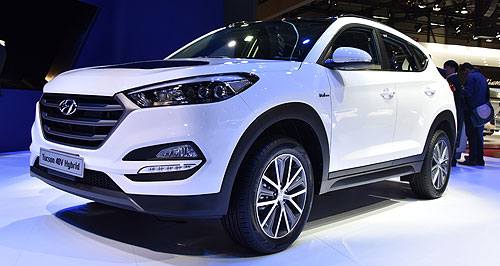Make / Model Search
Future models - Hyundai - TucsonGeneva show: Hyundai plugs in new hybridsPower off: The Hyundai Tucson hybrid and plug-in hybrid are likely for production but no sales are planned for Australia Hyundai expands its electric program with two new Tucson-based SUV concepts9 Mar 2015 By NEIL DOWLING HYUNDAI has further expanded its electrified vehicle program, announcing plug-in and hybrid concepts of the next Tucson at last week's Geneva motor show. The Tucson plug-in hybrid (PHEV) can consume as little as 1.8 litres of fuel per 100 kilometres and has an electric-only range of more than 50km. It would compete with vehicles including the Australian-market Mitsubishi Outlander PHEV that sips 1.9L/100km and offers a range of 52km. But Hyundai’s global hybrid and PHEV program – that includes the Tucson and the mid-size American-market Sonata – does not yet include Australia. Hyundai Motor Company Australia (HMCA) public relations manager Guido Schenken said local sales of the Tucson PHEV and hybrid are unlikely at this stage, given the potentially low volume and higher prices. “We regularly review the business cases of Hyundai’s hybrid vehicles,’’ he said. “But it’s difficult to justify on price and sales. “The Sonata hybrid is sold in the US. But in Australia we would have strong competition from the locally built Toyota Camry Hybrid. “Long term we do see a future but there has to be a viable business case.’’ Mr Schenken said HMCA was open to new technologies, and highlighted the ix35 hydrogen fuel-cell vehicle that arrived in Down Under as part of a feasibility study lat last year. “In Australia we have a fuel-cell trial car and established the refueling infrastructure at our Sydney head office,” he said. “We have one car now but plan to add two more at a later stage. It’s something we wanted to do to showcase the technology.” The Tucson PHEV has an 85kW 1.7-litre turbo-diesel engine driving the front wheels through Hyundai’s new seven-speed dual-clutch automatic transmission. A 50kW electric motor drives the rear wheels. The combined output is 135kW/474Nm and both power units can operate independently or together, providing a rear-drive, front-drive or all-wheel drive configuration. Hyundai said the Tucson plug-in hybrid had a 48-volt system and a powerplant design that was one-quarter less expensive to build than previous hybrids. “Especially suited to fitment in larger cars and SUVs, the show car’s 48V Hybrid technology comprises a Hybrid Starter Generator (HSG) – an electric motor replacing the conventional starter - an inverter and a low voltage DC/DC converter,” Hyundai said in a statement. “The HSG supports the diesel engine with its additional output, enables the ISG to restart the engine with almost no noise or vibration and acts as a generator during deceleration, recharging the 48-volt lithium-ion battery.” Hyundai’s second concept based on the Tucson is the hybrid, which uses a 2.0-litre turbo-diesel engine and a supplementary electric motor attached to the engine’s flywheel that doubles as the starter motor. Hyundai says it has a 4.1L/100km fuel economy average and combined output of 110kW/413Nm. The concept weighs only 20kg more than a conventional Tucson diesel. In the United States, the Sonata will this year be available as a conventional petrol-engined sedan, a hybrid and a PHEV, the latter two unveiled at January's Detroit motor show. The PHEV will only be sold in the 10 states of the US classed as the “California emission states”. It has a 145kW 2.0-litre petrol engine and a 50kW electric motor and is capable of consuming 5.1L/100km. The electric-only range is 35km. Hyundai said the PHEV can be recharged in five hours from a US power point of 110-volts, but half that for a 240V supply. The Sonata Hybrid, also expected on sale later this year in the US, is the second generation of the model. For 2015 it has similar engine and motor components as the PHEV.  Read more17th of February 2015  Geneva show: Hyundai Tucson connects with futureNew ix35-succeeding Tucson will be first Apple/Android compatible Hyundai4th of February 2015  Hyundai switches back to TucsonName change for Hyundai's top-selling SUV to Tucson following global decisionAll future models Alfa Romeo Alfa Romeo Abarth Abarth Alpine Alpine Alpina Alpina Audi Audi Aston Martin Aston Martin BMW BMW Bentley Bentley Chery Chery Brabham Brabham Chrysler Chrysler Chevrolet Chevrolet Cupra Cupra Citroen Citroen DS DS Dodge Dodge Fiat Fiat Ferrari Ferrari Foton Foton Ford Ford Great Wall Great Wall FPV FPV Haval Haval GWM GWM Honda Honda Holden Holden Hummer Hummer HSV HSV Infiniti Infiniti Hyundai Hyundai Jaguar Jaguar Isuzu Isuzu Kia Kia Jeep Jeep Land Rover Land Rover Lamborghini Lamborghini Lexus Lexus LDV LDV Mahindra Mahindra Lotus Lotus Mazda Mazda Maserati Maserati Mercedes-AMG Mercedes-AMG McLaren McLaren MG MG Mercedes-Benz Mercedes-Benz Mitsubishi Mitsubishi Mini Mini Opel Opel Nissan Nissan Peugeot Peugeot Pagani Pagani Proton Proton Porsche Porsche Renault Renault Ram Ram Rover Rover Rolls-Royce Rolls-Royce Skoda Skoda Saab Saab SsangYong SsangYong Smart Smart Suzuki Suzuki Subaru Subaru Toyota Toyota Tesla Tesla Volvo VolvoTucson pricing
Motor industry news |
Click to shareHyundai modelsResearch Hyundai All future models Alfa Romeo Alfa Romeo Abarth Abarth Alpine Alpine Alpina Alpina Audi Audi Aston Martin Aston Martin BMW BMW Bentley Bentley Chery Chery Brabham Brabham Chrysler Chrysler Chevrolet Chevrolet Cupra Cupra Citroen Citroen DS DS Dodge Dodge Fiat Fiat Ferrari Ferrari Foton Foton Ford Ford Great Wall Great Wall FPV FPV Haval Haval GWM GWM Honda Honda Holden Holden Hummer Hummer HSV HSV Infiniti Infiniti Hyundai Hyundai Jaguar Jaguar Isuzu Isuzu Kia Kia Jeep Jeep Land Rover Land Rover Lamborghini Lamborghini Lexus Lexus LDV LDV Mahindra Mahindra Lotus Lotus Mazda Mazda Maserati Maserati Mercedes-AMG Mercedes-AMG McLaren McLaren MG MG Mercedes-Benz Mercedes-Benz Mitsubishi Mitsubishi Mini Mini Opel Opel Nissan Nissan Peugeot Peugeot Pagani Pagani Proton Proton Porsche Porsche Renault Renault Ram Ram Rover Rover Rolls-Royce Rolls-Royce Skoda Skoda Saab Saab SsangYong SsangYong Smart Smart Suzuki Suzuki Subaru Subaru Toyota Toyota Tesla Tesla Volvo VolvoTucson pricing
Motor industry news |











Facebook Twitter Instagram